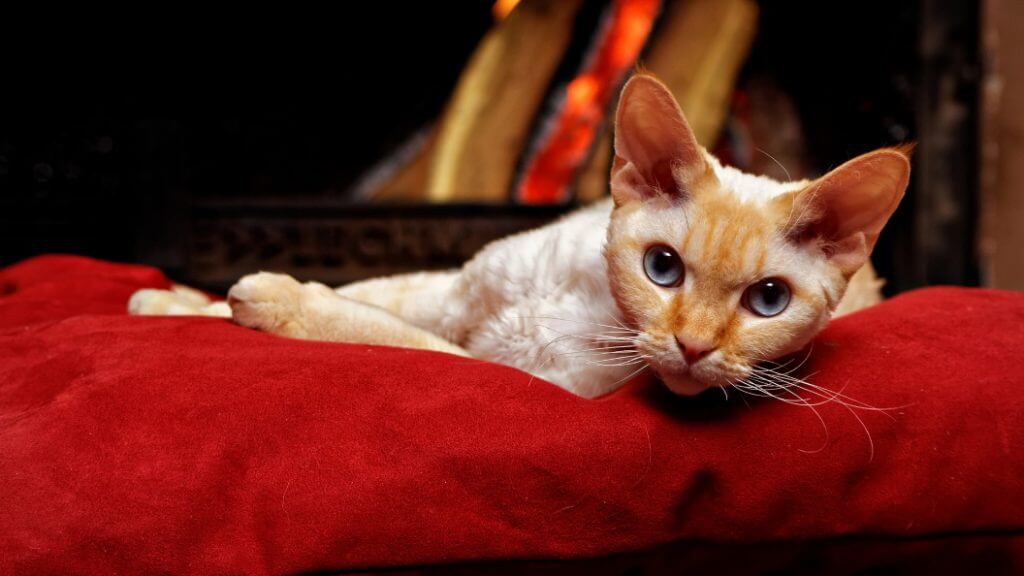This post may contain affiliate links. You can view our affiliate disclosure here.
If you’re a typical concerned cat owner, you’ll check what’s in the litter box every time you scoop it out to check for worms or other problems such as diarrhea.
Seeing blood in your cat’s stool can cause a panic, understandably. But what does it mean? In this article, we’ll discuss causes and solutions for the issue.
What should a normal cat stool look like?
A normal cat stool resembles a Tootsie Roll, around two to three inches long and a half inch in diameter. It should be rather soft and moist, but not crumbly.
If you’re squeamish about handling it, try using gloves or pressing on it with your scoop. Because the color is usually rather dark, it may be hard to detect blood on the stool, especially if the source is higher up in the small intestine which tends to produce darker blood on the stool.
Mucus can also be seen in the stool, and more mucus than usual is another sign of a possible problem.
A good tip is to watch for blood smearing on the litter pan or scoop while you’re trying to corral the waste for disposal.
Is blood in cat stool a cause for panic?

Blood in cat stool is not necessarily life-threatening. However, as there are so many possible causes, the best solution is a visit to the vet or at least a phone conversation to find out the source.
Remember that cats are really good at hiding illness, and signs that something is wrong are usually subtle.
Be ready to tell the vet whether the rest of the stool is normal in texture, odor and color or is accompanied by diarrhea. Also be aware of any recent changes in diet or living conditions.
Besides the more serious causes, there are many minor causes. This is where having the same vet treat the cat every time can aid in diagnosis, because the cat’s health history can sometimes provide clues as to the source of the problem.
Possible Causes
Possible causes of blood in your cat’s stool include:
1. Cancers Or Tumors
These will probably have to be discovered through X-rays or ultrasound tests.
2. Parasites
While sometimes parasites are visible on the stool themselves, this is not always the case. A fecal test can usually detect worm eggs that are too small to see.
3. Colitis
This is an inflammation of a cat’s colon. It can be caused by parasites, food allergies and even stress.
Colitis is often accompanied by mucus in the stool, diarrhea or constipation, lack of appetite and/or accompanying weight loss.
Stressful situations such as boarding or the introduction of another pet into the family can cause this condition.
4. Infection

Infection can exist in the anal glands or higher up in the digestive tract. A blood test can usually detect whether an infection is present.
5. Food Problems
These can range from a change in diet to a food allergy.
Usually, changing a cat’s diet should be done gradually to give their digestive system a chance to get used to the new foods. An allergy may develop which will necessitate tracking down the offending item — often a time-consuming process of discontinuing one item at a time until the culprit is found.
6. Poison Or Injury
These are the kinds of problems which can only be definitively diagnosed by a vet.
In terms of poisoning, look out for signs like vomiting, salivating, twitching, or swelling. When it comes to injury, look out for signs like limping, slowness, or visible wounds on the body.
7. Stress
This can be caused by a moving to a new residence, boarding, or even introducing a new cat into the family.
Stress caused by moving can be addressed by keeping the cat crated in a calm place while the furniture and other items are moved in, and then letting the cat explore the new surroundings at its own pace. Being nearby to offer reassurance will help.
When introducing a new cat, it’s best to keep the new resident isolated if possible, and introducing the two a little at a time. Make sure the new cat has its own bed and toys so that your previous cat doesn’t smell the scent of an interloper on its things.
Remedies

Treatment will, of course, depend upon the actual cause of the blood.
Parasites will be treated with dewormers. Food allergies may take a little longer to ascertain the exact offending ingredient so it can be removed from the pet’s diet.
Medication may well be prescribed, especially with diarrhea, and sometimes fluids may be administered to combat dehydration. Surgery is another possibility.
Conclusion
You don’t need to panic if you do see blood in cat stool, but it is one of those conditions that should not be ignored.
While in all probability it will be something minor that doesn’t require much intervention, you need to make sure. Cats are rather small animals, after all, and a minor situation can become worse quickly if not treated.
If you haven’t been keeping an eye on your cat’s waste output, it would be a good idea to start.



